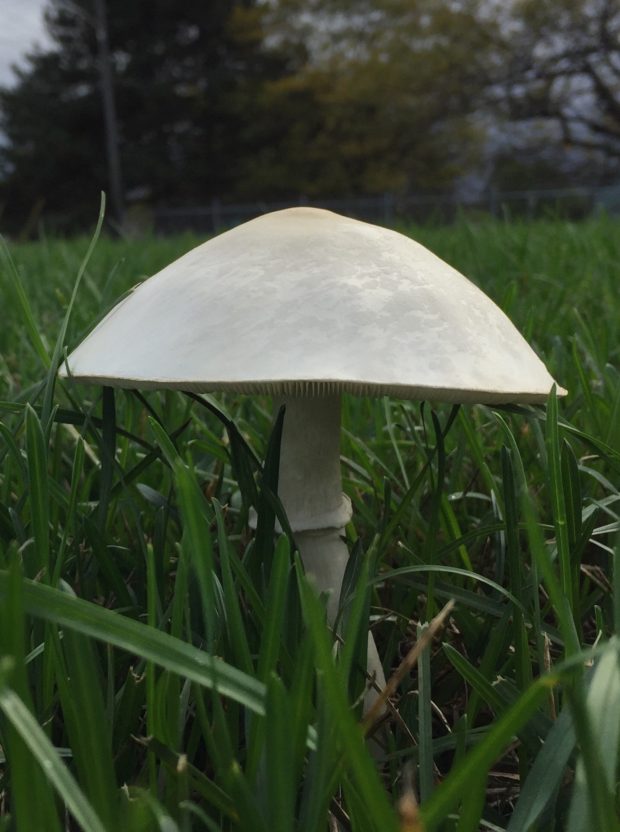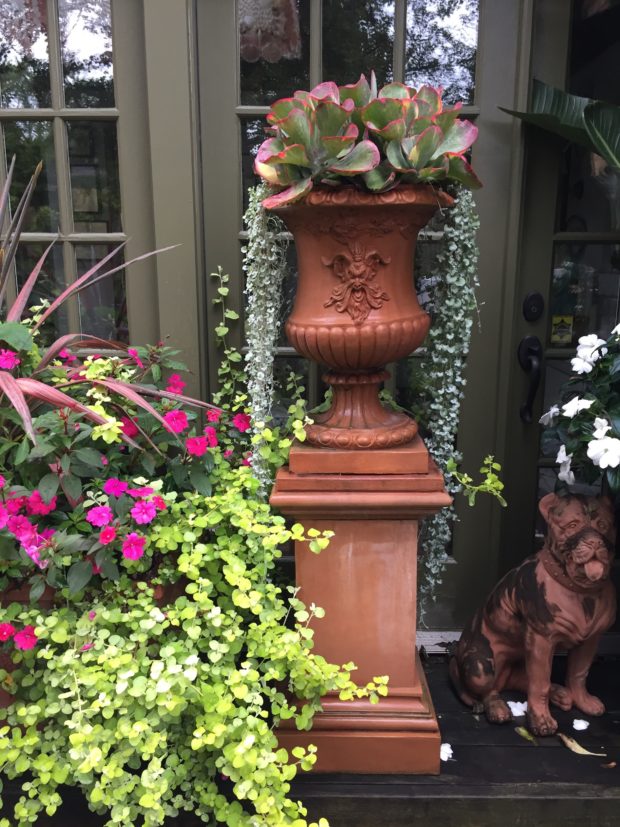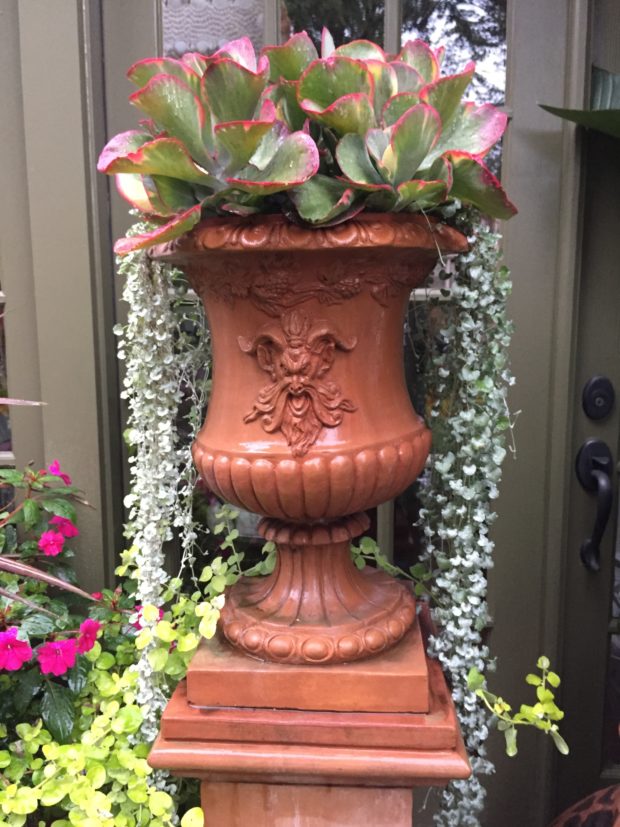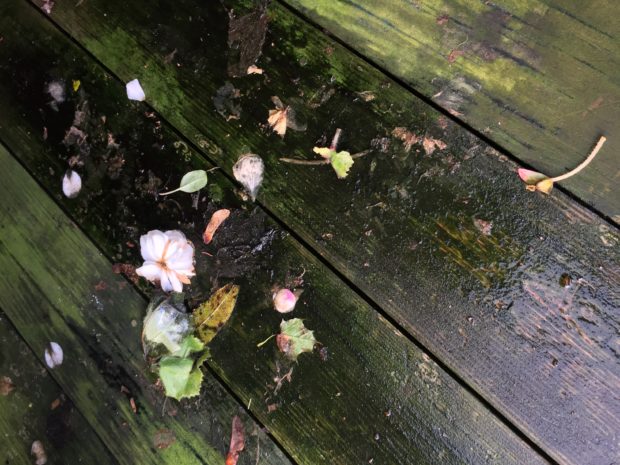 If you garden in southeastern Michigan, your garden is drenched. We have had the kind of steady hard rain spanning a good many days that I call mushroom rain. I see them popping up everywhere. I am not complaining. We have had a very dry summer, and a hot and dry early fall. The cabbage and kale at the shop have needed daily water. My pots at home needed water just about that often. I have worried about the dogwoods that need water in September to set good buds for the following spring, and the evergreens that need to be water loaded and juicy before the ground freezes. I know from my large tree contractor that our ground is dust dry, down deep. The trees he has been digging with a large tree mover have dry rootballs. This has made me very uneasy about what a very cold and windy winter might mean to a plant that has not had sufficient water during the growing season. Few perennials, shrubs or trees are prepared for the winter having gone through the summer and fall bone dry. But for those few plants that rely on dryer winter conditions for survival – though I am sure there are plenty, I am thinking some species of iris, and lavender that do not tolerate wet winter conditions – most plants like a little stored water and nutrients before they have to face the winter. Perennials whose tops die back to the ground in the fall still have a robust and juicy root system that sustains them through the winter. Deciduous shrubs shed their leaves in the fall-yes. But their living stems will need to survive all the harsh conditions that a winter has to dish out, and enough stored energy left over to leaf out in the spring.
If you garden in southeastern Michigan, your garden is drenched. We have had the kind of steady hard rain spanning a good many days that I call mushroom rain. I see them popping up everywhere. I am not complaining. We have had a very dry summer, and a hot and dry early fall. The cabbage and kale at the shop have needed daily water. My pots at home needed water just about that often. I have worried about the dogwoods that need water in September to set good buds for the following spring, and the evergreens that need to be water loaded and juicy before the ground freezes. I know from my large tree contractor that our ground is dust dry, down deep. The trees he has been digging with a large tree mover have dry rootballs. This has made me very uneasy about what a very cold and windy winter might mean to a plant that has not had sufficient water during the growing season. Few perennials, shrubs or trees are prepared for the winter having gone through the summer and fall bone dry. But for those few plants that rely on dryer winter conditions for survival – though I am sure there are plenty, I am thinking some species of iris, and lavender that do not tolerate wet winter conditions – most plants like a little stored water and nutrients before they have to face the winter. Perennials whose tops die back to the ground in the fall still have a robust and juicy root system that sustains them through the winter. Deciduous shrubs shed their leaves in the fall-yes. But their living stems will need to survive all the harsh conditions that a winter has to dish out, and enough stored energy left over to leaf out in the spring.
 The dormant/winter season for plants is nothing like my winter sleep. My blankets and a dose of house heat keeps me warm. Nothing about me or around me freezes. A usual night’s sleep is 8 hours or so. A temporary respite. Mammals that hibernate the entire winter season astonish me. They do not come out of hibernation especially ready to face the day. They have lost a lot of weight, and are very hungry and thirsty. Hibernation is not at all like a good night’s sleep. I am reminded of the time a surgeon advised me that I would not be “asleep” for my surgery. I would be unconscious, and all of my normal functions paralyzed. A machine would breathe for me. The surgical team would see to it that my life was sustained. Though I appreciated his candor, I was frightened by this. No plant has a surgical team standing by. Their condition going into the winter will either be enough to sustain them throughout, or not. Our winter is not a big sleep. Dormant means shut down. Strong winter winds and low temperatures take their toll on plants whose only defense against the winter was a kindly summer and fall season. Needless to say, I have been watering like crazy.
The dormant/winter season for plants is nothing like my winter sleep. My blankets and a dose of house heat keeps me warm. Nothing about me or around me freezes. A usual night’s sleep is 8 hours or so. A temporary respite. Mammals that hibernate the entire winter season astonish me. They do not come out of hibernation especially ready to face the day. They have lost a lot of weight, and are very hungry and thirsty. Hibernation is not at all like a good night’s sleep. I am reminded of the time a surgeon advised me that I would not be “asleep” for my surgery. I would be unconscious, and all of my normal functions paralyzed. A machine would breathe for me. The surgical team would see to it that my life was sustained. Though I appreciated his candor, I was frightened by this. No plant has a surgical team standing by. Their condition going into the winter will either be enough to sustain them throughout, or not. Our winter is not a big sleep. Dormant means shut down. Strong winter winds and low temperatures take their toll on plants whose only defense against the winter was a kindly summer and fall season. Needless to say, I have been watering like crazy.
 I have no idea if the torrential rains we have had the past week will be enough to sustain my shrubs and trees through the winter, but it can’t hurt. I have not dug down to see how deep this rain has penetrated, but I know enough to be happy for every drop we have had.
I have no idea if the torrential rains we have had the past week will be enough to sustain my shrubs and trees through the winter, but it can’t hurt. I have not dug down to see how deep this rain has penetrated, but I know enough to be happy for every drop we have had.
Our fall is usually cool, and the rain is somewhat regular. It is a perfect time to plant. The weather is mild. The plants are no longer in active growth, so moving them is less stressful. Unlike the spring season, when planting conditions can be less than ideal. The soil is freezing cold even though the ground has thawed. Sopping wet spring soil can be a poor environment for newly planted plants. The act of planting compacts the wet soil, driving out much needed air. The night time temperatures can swing up and down without warning. Spring is a sweet season for established plants, but can be very tough on new plantings. Who in Michigan has not witnessed tulips in full bloom encased in ice, and snow on the ground? So many times, my hope to plant a landscape in late March has had to wait until May. Michigan summers can be brutal. The heat and dry in the summer can be hard on transplanted trees, shrubs and perennials. No matter how much I water, the plants look grief stricken. Fall planting is a recipe for success in my zone. Though the daytime/night time temperatures are cool, the soil is much warmer than it was in the spring. The water from the sky seems like it is packed with vitamins and minerals, doesn’t it?
 I am delighted with the prolonged rain. I hope that water has made some inroads on our dry soil. Cool fall temperatures mean that rain does not evaporate very quickly. The effects of our heavy rains will surely persist. I could have never delivered this volume and quality of water from my hose. My container plantings are most certainly coming to the end of their season. But the recent rains have endowed them with some saturated fall color.
I am delighted with the prolonged rain. I hope that water has made some inroads on our dry soil. Cool fall temperatures mean that rain does not evaporate very quickly. The effects of our heavy rains will surely persist. I could have never delivered this volume and quality of water from my hose. My container plantings are most certainly coming to the end of their season. But the recent rains have endowed them with some saturated fall color.
 A rain drenched garden is a good looking garden. Even these drought tolerant variegated kalanchoes look invigorated by the rain. I can think of only a very few times when my garden was threatened by excessive rain. In most cases, water distress has more to do with poor drainage than too much rain. Our parched ground may not be restored to a normal moisture content by our recent rains, but every drop of it is appreciated.
A rain drenched garden is a good looking garden. Even these drought tolerant variegated kalanchoes look invigorated by the rain. I can think of only a very few times when my garden was threatened by excessive rain. In most cases, water distress has more to do with poor drainage than too much rain. Our parched ground may not be restored to a normal moisture content by our recent rains, but every drop of it is appreciated.
 Chilly, windy and rainy fall weather-bring it on. We have more to plant.
Chilly, windy and rainy fall weather-bring it on. We have more to plant.
I, too, have been so very thankful for the deluge we received here in SE Michigan. Week before last (during the lovely early fall weather we had) a landscape crew completed a large project in my yard with numerous trees and shrubs and grass seed. Seemingly minutes after the last wheelbarrow of mulch was laid, the rain started. WooHoo!!!! My grass seed has sprouted, the trees and shrubs look happy and the new drainage system worked to perfection. This week, I hope to plant daffodil and allium bulbs in the now soft, moist soil.
Loved reading this for it’s poetic content as well as information.
“Ode to Fall Rain”
This is a beautiful essay Deborah; and a great example why I love your blog. I live in a very rainy area in the foothills of the North Cascades that separate western from eastern Washington state. However we have had the driest and warmest summer on record; our pines, cedars and other great trees and evergreens are stressed. Especially after reading your post today, I look forward to the heavy rain predicted for this week. All my best to you.
Thank you Deborah for this beautifully written essay on rain and fall planting a. I always learn somet from you!! ❤️
Those kalanchoes look amazing in your terracotta urns!
My husband and I leave for Missouri, zone 6. We are planting a garden in my daughter’s front yard. No more grass, just stone paths, perennials, shrubs and conifers. I hope the perennials make it through the winter. Any advice you can give would be helpful. The plan is to make it colorful in spring and fall when they are at home.
I have heard, although I don’t know if it’s true, that rainwater has far more nitrogen in it than hose water. What say you?
Rainy fall days never sounded as interesting, or inviting, as what you wrote today. Thank you, Deborah, for your always artful use of both shovel and pen. Tom in NC.